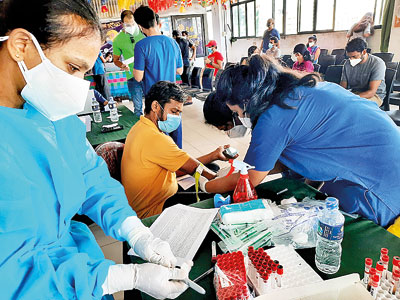News
Important findings on AstraZeneca & Sinopharm from vaccine studies

Prof. Neelika Malavige
‘Neutralizing’ antibodies are very important, reiterates Prof. Neelika Malavige, pointing out that they block the virus from attaching itself to the host (a person’s) cell receptors.
The findings of her team which included Dr. Chandima Jeewandara are:
With 1 dose of AstraZeneca, over 93% of the people developed a neutralising antibody response for the wild virus, while it reduced to 84.6% by 12 weeks from a single dose.
The T cell response from 1 dose of AstraZeneca was better than 2 doses of Sinopharm. (T cells are a type of white blood cells which are part of the immune system.)
With 2 doses of Sinopharm, 81.25% of the people developed a neutralizing antibody response to the wild virus, similar to levels seen following natural infection.
Among those in the 20 to 39-year group, 98.9% who got both Sinopharm jabs developed these antibodies, while among those in the >60 years group it was 93.3%.
When considering the variants of concern:
12 weeks after the first dose of AstraZeneca, antibodies to the receptor binding domain had reduced 4.7 fold to Delta (the Indian variant) when compared to the original virus and 4.6 fold lower than that of the natural infection. This suggests that immunity to variants wanes with time, which is compatible with the results from other countries.
The 16-week data indicated that the neutralizing antibody response of AstraZeneca varied from one group to another – in the younger group it was okay but in the elderly it “was not good”.
With regard to Sinopharm, the antibody levels to Delta and Beta (the South African variant), were similar to levels following natural infection although the antibody levels were lower for Alpha (the United Kingdom variant).
The vaccine recipients of Sinopharm had a 1.38-fold reduction in antibody levels to Delta compared to the Wuhan variant and a 10-fold reduction to Beta. The vaccine also induced T cell and memory B cell responses.
The research team had included scientists Prof. Graham Ogg and Prof. Alain Townsend from the University of Oxford. The funding for the Sri Lankan team had been from the WHO, UK Medical Research Council and the Foreign and Commonwealth Office and for the Oxford team from the UK Medical Research Council and the Chinese Academy of Medical Sciences (CAMS) Innovation Fund for Medical Science (CIFMS), China.
Vaccines being given in SL
AstraZeneca (AZD1222 – ChAdOx1) – manufactured by the British-Swedish multinational pharmaceutical and biotechnology company AstraZeneca and University of Oxford, it is produced in two factories in the UK as well as several around the world including India, South Korea, Netherlands and Germany. This two-dose vaccine is on an adenovirus (from chimpanzees) base.

Taking the blood samples for the vaccine studies
Sputnik V (Gam-COVID-Vac) – manufactured by the Gamaleya Research Institute in Russia, it is being produced in Russia, India, Serbia and Argentina. This two-dose vaccine is on an adenovirus (Ad5 and Ad26) base.
Sinopharm (BBIBP-CorV) – manufactured by the Beijing Institute of Biological Products, it is produced in China and the United Arab Emirates. This two-dose vaccine is an inactivated vaccine.
Pfizer (BNT162b2) – manufactured by the New York-based Pfizer company and the German company BioNTech, it is being produced in Sweden, Germany and the United States of America (USA). This two-dose vaccine is an mRNA vaccine.
Moderna (mRNA-1273) – manufactured by an American pharmaceutical and biotechnology company of the same name based in Massachusetts, it is produced in the USA, Switzerland, France and Spain. This two-dose vaccine is an mRNA vaccine.

